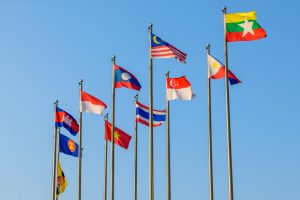On April 4, in a move that has sent tremors through global markets, U.S. President Donald Trump announced a sweeping series of country-specific tariffs. This included harsh levies on all 10 member states of the Association of Southeast Asian Nations (ASEAN). Justified by trade imbalances, alleged unfair subsidies, and national security concerns, Washington’s decision signals a serious recalibration of global trade dynamics – and places Southeast Asia directly in the line of fire.
Effective from April 9, the tariffs, which range from 10 percent (in the case of Singapore) to nearly 50 percent (in the case of Cambodia), will apply to almost all products exported from ASEAN countries to the U.S., with only a few exceptions. For individual ASEAN economies, the implications could well be profound. Many have long depended on export-led growth, with the United States playing a crucial role as a major market.
The claim that developing nations have taken advantage of the U.S. economy overlooks the fact that American consumers have reaped the benefits of affordable, high-quality goods for decades. These products are manufactured through the tireless labor of workers across the Global South, including many Southeast Asians.
These new tariffs threaten to disrupt global supply chains, deter investment, and slow GDP growth, at a time when ASEAN nations urgently need robust economic performance to combat poverty, improve education, and address climate change.
At the regional level, fragmented trade flows risk weakening ASEAN’s collective influence in the global economy. As U.S. measures weaken or sever interconnected supply chains, intra-ASEAN trade may falter, especially if member states begin adopting inward-looking policies to protect their own domestic industries.
ASEAN’s status as a unified economic bloc, which is projected to become the world’s fourth-largest economy by 2030, risks being undermined if countries fail to coordinate responses to these external shocks.
Beyond economic metrics lies the likely human toll of the Trump tariffs. Millions of working-class citizens –particularly in manufacturing hubs like Indonesia, Thailand, and Vietnam – face the grim prospects of declining export demand, reduced factory output, and job losses. Small and medium enterprises (SMEs), which make up more than 90 percent of ASEAN businesses, are especially vulnerable. Operating on narrow margins and often lacking access to credit, many SMEs will struggle to absorb the impact of new tariffs or pivot to alternative markets.
Consumers, especially, will feel the pain. As demand softens and supply chains shift, imported goods will become costlier and scarcer. The situation could worsen if the U.S. dollar strengthens or interest rates remain high, which could cause inflation in essential goods such as food, fuel, and drugs. These inflationary pressures will disproportionately affect lower-income households, deepening inequality across a region still recovering from the COVID-19 pandemic and grappling with the rising cost of living. Without meaningful interventions by Southeast Asian governments, these economic shocks will undermine people’s dignity, security, and livelihoods, and could potentially translate into social crises.
Moreover, history shows us that economic instability often leads to political instability. In Southeast Asia, where democratic institutions in several countries remain fragile, there is a real risk that this economic shock could fuel populism, xenophobia, or authoritarian consolidation.
Governments, desperate to maintain control or stave off unrest, may curtail freedoms, silence dissent, or target vulnerable communities. Civil society, independent media, and labor unions, already under pressure in parts of the region, could face greater restrictions. The narrowing of civic space and erosion of democratic checks and balances must not be seen as collateral damage, but as a central concern in how we navigate this crisis.
If ASEAN fails to respond with rights-based and democratic governance at its core, the region may emerge from this crisis more divided, more unequal, and less free.
Trump’s tariffs represent not merely a trade dispute, but a structural rupture in the international economic order that has prevailed since World War II. This unprecedented crisis will also pose a crucial test of ASEAN’s unity and resilience. If ASEAN responds piecemeal – country by country, sector by sector – it will lose ground. But if it acts collectively, it can emerge stronger, tempered by the economic crisis.
To begin with, the region must deepen intra-ASEAN economic integration by accelerating initiatives such as the ASEAN Trade in Goods Agreement upgrade, further harmonizing standards, and reducing non-tariff barriers to intra-ASEAN trade. Investment in regional infrastructure, digital trade, and sustainable industries can create new engines of growth, less dependent on volatile external markets. Crucially, ASEAN must also present a unified voice in global forums like the WTO and the G-20, advocating for fair and open trade.
Above all, policies must be crafted with people at the center. Social safety nets, upskilling programs, and SME support mechanisms must be scaled up to cushion Southeast Asian citizens from the impact of the current global shifts. A more connected and compassionate ASEAN – one that not only competes but also fosters trust – will help determine whether ASEAN can successfully weather the coming storm.

































